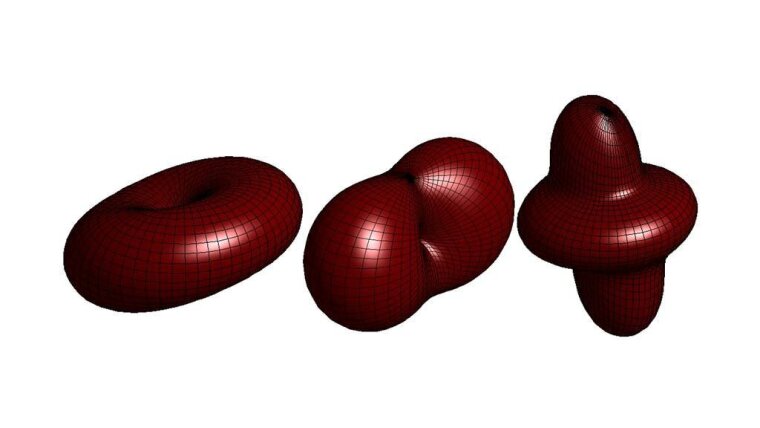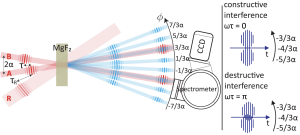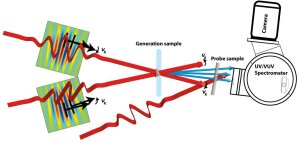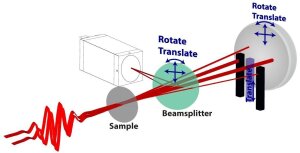
The group studies the interaction of laser light and matter at intensities above the limit that can be described by traditional nonlinear optics. The intensity is too high for the power series expansion of nonlinear optics to converge, but still low enough for quantum coherences to prevail. This field of research, which is called strong field physics or extreme nonlinear optics, leads to phenomena that occur on the attosecond time scale, and at the same time offers the possibility to generate light bursts of attosecond duration. Scientific findings on ultrafast physics and the technological development of ultrafast light sources go hand in hand.
In recent years, promising progress has been made in strong-field light matter interaction in solid materials. Due to their higher density, the generation of high-order harmonics (HHG) from solids could surpass gas-phase sources in terms of conversion efficiency. In addition, the required intensity for HHG from solids is much lower compared to the gas-phase, thus easing the demands on the drive laser. Together with the avoidance of the vacuum beam lines required for gas-phase HHG, solid-state attosecond technology could be applied more widely with simpler and more compact experimental setups.
One goal of the group is to develop new methods of laser pulse generation. Up to now, laser pulses with a duration of one femtosecond or shorter could only be generated in the Vis-IR as well as in the extreme UV, but the deep UV is a spectral range in which such extremely short laser pulses were not available before. Harmonic concatenation is our new method for the synthesis of ultrashort pulses, which delivers record short deep UV waveforms of only 1.5 fs.
Another goal is to understand the physics on the electronic time scale by attosecond spectroscopy. For the manipulation of pump and probe pulses in the Vis-IR and extreme UV, beamlines of several meters in length are normally required. We have developed beamlines on a centimeter scale which facilitate transient absorption and dispersion in the deep UV range. The aim of this project is to measure the nonlinear reaction time of thin glasses, crystals and liquid films to explore the limits of light-induced signal processing.
Harmonic concatenation
Harmonic Concatenation
Image: Adrian PfeifferWaveforms with durations short enough to probe the electronic timescale can be generated both in the extreme UV and in the visible-infrared (Vis-IR) region of the electromagnetic spectrum. High-order harmonic generation can be used to generate isolated attosecond pulses and pulse trains in the extreme UV, and since very recently the coherent synthesis of optical pulses is used to generate subcycle optical waveforms in the Vis-IR region. In the deep UV (DUV), where many basic aromatic molecules absorb radiation and undergo photochemical reactions, pulses with such extremely short durations have not yet been demonstrated.
Harmonic concatenation is our new method for the synthesis of ultrashort pulses. The principle is the concatenation of spatial and temporal harmonics that are created by two noncollinear Vis-IR pulses. Cascaded processes of frequency conversion and self-diffraction in a thin dielectric plate yield a multifaceted emission pattern of temporal and spatial harmonics. The emission angle of the harmonic orders depends on the frequency. This spatiotemporal coupling is exploited to concatenate two neighboring spatial harmonics by adjusting the crossing angle of the fundamental pulses. Broadband waveforms arise, of which the lower frequency bands belong to one spatial harmonic, and the higher frequency bands belong to the other spatial harmonic. In order to synthesize ultrashort waveforms from these frequency bands, their phases must be adjusted. This is accomplished by controlling the groove-envelope phase (GEP) of the fundamental pulses, which is determined by their delay on the subcycle timescale. Using temporal harmonics of third order, the concatenation of two spatial harmonics synthesizes record-short deep UV waveforms of only 1.5 fs!
J. Reislöhner, C. Leithold, and A. N. Pfeiffer, "Harmonic concatenation of 1.5-femtosecond-pulses in the deep ultraviolet", ACS Photonics, 10.1021/acsphotonics.9b00219 (2019).
Transient absorption with miniature beamlines
Miniature beamline
Image: Adrian PfeifferThe wavelength range with photon energies of 5-15 eV is very important for spectroscopic methods, since binding energies of valence electrons are usually located within this range. For example, in order to observe the transient change of band structures in dielectrics and the related screenings in the presence of a strong field pulse, probe pulses are required that i) have a duration shorter than the optical period of the strong field pulse, ii) encompass the wavelength of the dielectric bandgap, and iii) are available at the sample position.
We develope a miniature beamline for transient absorption, a novel method in attosecond spectroscopy. Harmonic concatenation is an ideal source, because a generic feature is that these waveforms are spatially separated from the fundamental pulses and are therefore available for immediate spectroscopic usage without any subsequent optical elements.
Subcycle nonlinear spectroscopy
Subcycle Nonlinear Spectroscopy
Image: Adrian PfeifferWe explore the timing of the nonlinear response of thin glasses, crystals and liquid films. These materials have a band gap in the range of 5-10 eV and therefore a much shorter response time than semiconductors. The implications concern the limits of light-induced signal processing.
Through noncollinear interaction of fundamental light pulses inside the samples, additional light pulses are generated whose time course reflects the nonlinear dynamics in the medium. This dynamic is measured by recombining the generated pulses with the fundamental pulses. A suitable optical system must guarantee equal path lengths for all pulses after the interaction in the sample, which is normally not possible due to surface irregularities of the optics. In our novel approach, surface irregularities are compensated through a dynamic optical system.


